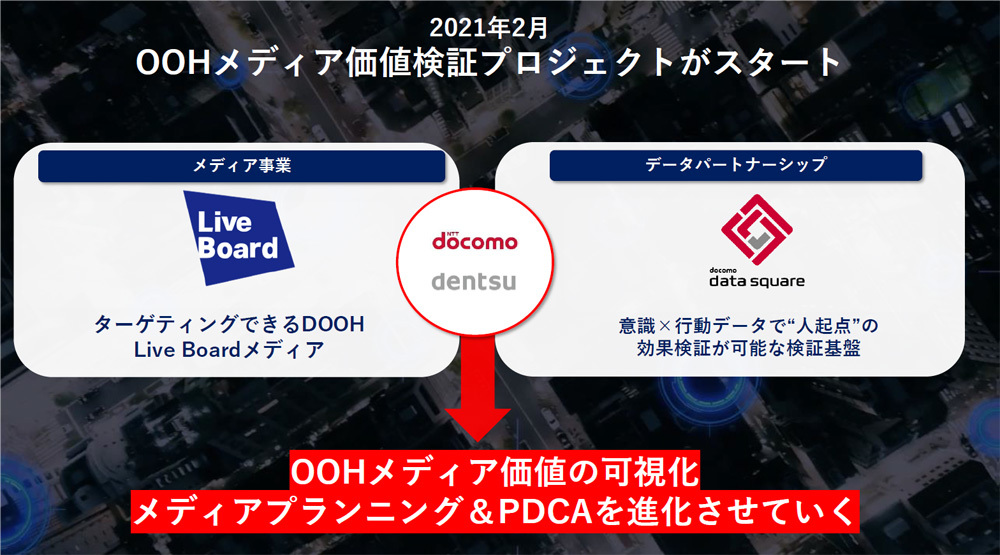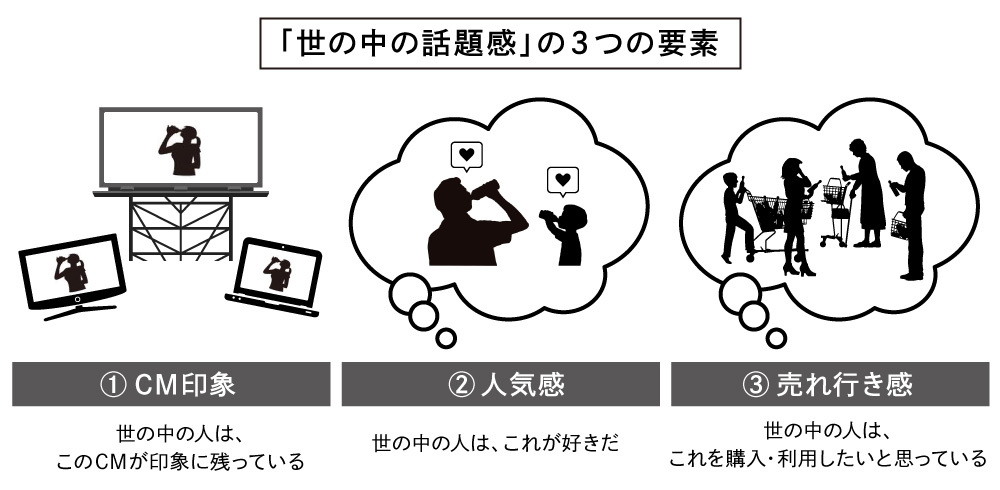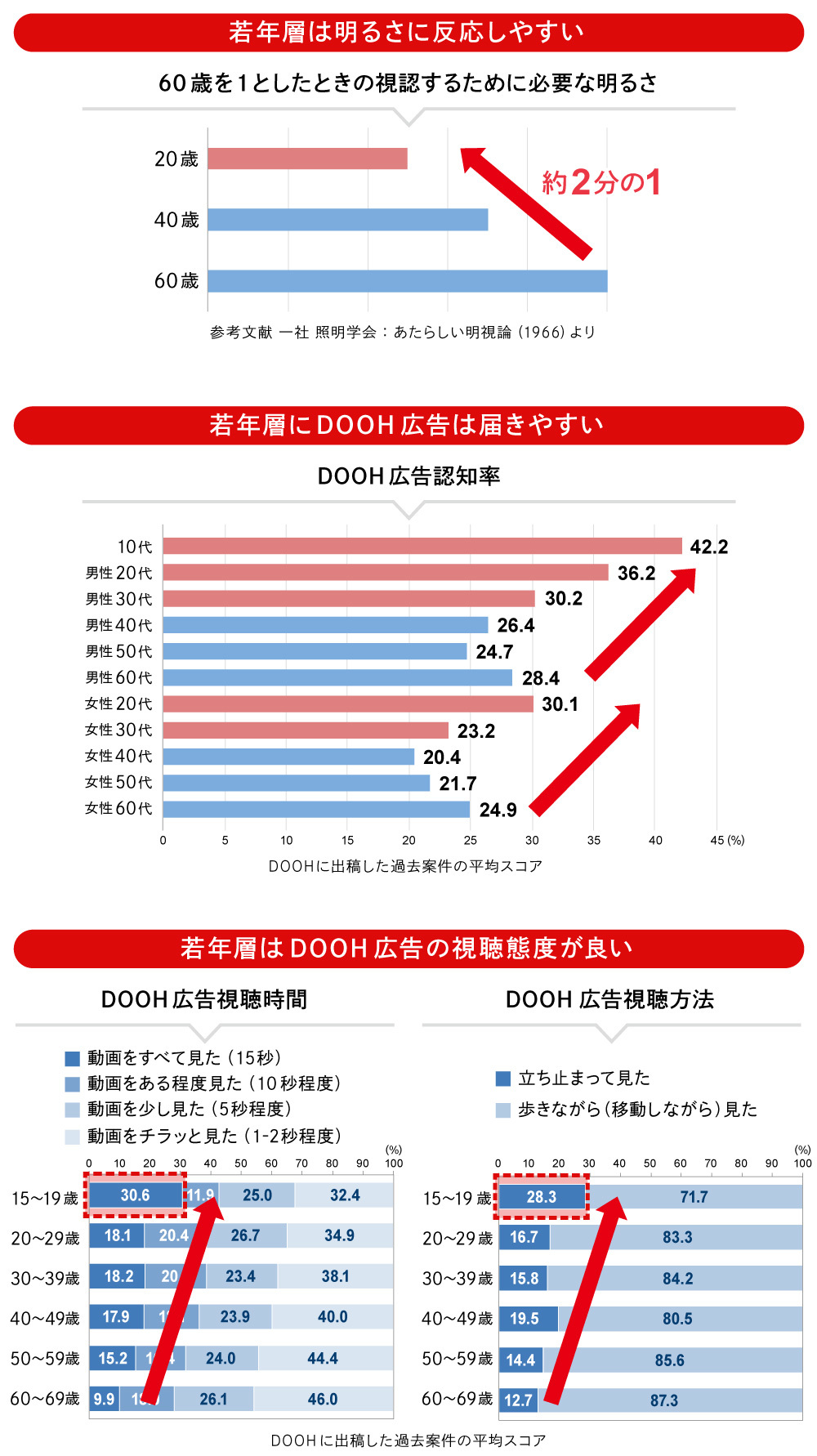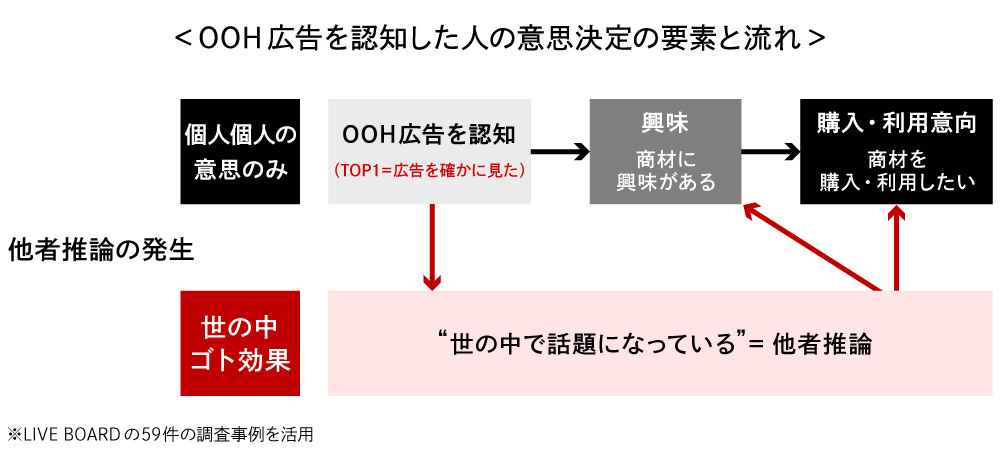OOH (Out Of Home) handles advertising exposure outside the home, such as street billboards and train advertisements.
Because OOH effectiveness is difficult to measure, key metrics have traditionally focused on reach and circulation – essentially, "how many people could potentially be exposed." However, we strongly feel that the actual purpose of OOH campaigns is increasingly shifting towards effects that cannot be explained by reach and circulation alone. These include aims like "making it a topic of conversation in society" or "effectively changing consumer attitudes through the buzz it generates."
Based on the hypothesis that OOH possesses this "societal impact effect," Dentsu Inc. launched an effectiveness verification project. We successfully visualized this "societal impact effect." Building on this, we developed a tool (beta version) enabling effective planning centered on attitude change. We now aim to initiate development of solutions that can be utilized going forward.

Following the first roundtable where Dentsu Inc. employees involved in OOH planning gathered to discuss OOH's hidden potential and methods for verifying its effects, this time we welcome Mr. Haruki Kobayashi from LIVE BOARD, which operates an OOH distribution platform, to discuss the verification results of the "societal impact effect."
Session 1: OOH Holds Hidden Value—"Societal Impact Effect"!
【Participants】
Haruki Kobayashi: After developing "OOH LIQUID," an OOH advertising effectiveness verification method utilizing location data at the OOH Division, he was seconded to LIVE BOARD. At LIVE BOARD, he supports the development of planning tools utilizing Docomo data (Mobile Spatial Statistics®※1 + other location data, etc.) and is responsible for data-driven planning and effectiveness verification.
Hiroshi Fukuda: Senior Solution Director, 3rd Integrated Solutions Bureau. Responsible for developing and planning solutions across various media, and also serves as a driving member for this OOH media "Real-World Impact Effect" project.
Kousuke Kasuya: Media Planner, Out-of-Home Media Division. He handles everything from media planning to the verification phase, primarily for OOH media. He has a proven track record of sales for LIVE BOARD across a wide range of industries and is constantly pioneering the future of OOH.
and is pioneering the future of OOH daily.
Akane Furuike: After working as a Planner in the OOH Division, she is now involved in developing integrated on/off planning and effectiveness verification schemes utilizing the "TV × Digital × OOH" triple media approach at the Data & Technology Center.
※1 "Mobile Spatial Statistics" is a registered trademark of NTT DOCOMO, INC.
High-Precision Effect Verification Platform Utilizing Docomo Data (Mobile Spatial Statistics® + Other Location Information, etc.)
Fukuda: The "Societal Buzz Effect" we advocate refers to the unique mass media effect where consumers encountering an ad develop the awareness that "everyone is seeing this ad" or "it must be trending," leading to increased understanding of the product/service and a lift in purchase/usage intent.
To visualize this "Societal Buzz Effect" for OOH, we utilized LIVE BOARD's verification platform. First, I'd like to ask Kobayashi-san to briefly recap LIVE BOARD's key features.
Kobayashi: LIVE BOARD is a joint venture company in the OOH space formed by NTT DOCOMO and Dentsu Inc. Utilizing DOCOMO's Mobile Spatial Statistics® and other location data, it enables Japan's first impression-based (ad viewership) ad delivery. Its key feature is being an OOH medium that delivers appropriate ads based on target audience, moment, and area, while also enabling effect verification.

Fukuda: So it's essentially DOOH (Digital Out of Home: advertising using digital signage). Not only does it enable planning that was difficult with traditional OOH, but it also offers advantages as a foundation for effectiveness verification, right?
Kobayashi: Traditional OOH effectiveness verification relied on surveys of people who reported being in the OOH's visible area. This inevitably depended on the respondents' memory and impressions, including whether they actually saw the OOH. LIVE BOARD, however, uses Docomo's location data to simultaneously confirm actual visit history. This allows us to precisely select survey respondents and provide highly accurate research on brand lift and attitude change.
Kasuya: The demand for "visualizing OOH effectiveness" is high. In fact, a video streaming service client regularly uses LIVE BOARD because "it enables proper research," and I get the impression more clients like this are emerging.
Kobayashi: Thank you. Our research has identified three key characteristics of OOH advertising effectiveness measured by LIVE BOARD:
① High recency effect (the ad influences purchasing behavior)
② Particularly strong appeal to younger demographics
③ The combined effect of TV × Digital × OOH further enhances the impact of ① and ②
While many likely imagined these effects existed, LIVE BOARD uniquely enables precise quantification and verification—including how OOH effectiveness varies by generation—which I believe is its compelling strength.
Fukuda: Precisely because the survey is so accurate, it enables verification of "real-world impact." Even just this verification platform alone makes me feel LIVE BOARD has significant potential to change the conventional wisdom around OOH.
The True Nature of "Real-World Effect": CM Impression / Popularity Perception / Sales Perception
Fukuda: With such an excellent verification platform, we should be able to prove OOH's "worldly effect." Based on that hypothesis, we proceeded with verification using LIVE BOARD. The key point is that "compared to simply recognizing an ad, when it becomes a topic of conversation in the world—meaning when inferences about others occur—it increases consumers' purchase and usage intent." We went through quite a bit of trial and error figuring out how to verify this.
Kobayashi: That's right. To pinpoint how OOH's sense of being a hot topic in society influences purchase/usage intent, structuring the entire continuum of consumer awareness—from ad recognition to purchase/usage intent—was extremely challenging.
Many people hear terms like "correlation exists" in research reports, but such analyses cannot establish "causation." Even if a correlation exists between "perceived buzz" and "purchase intent," it remains unclear whether "perceived buzz led to higher purchase intent" or "higher purchase intent led to the perception of buzz."
Fukuda: I see. So you needed to clarify the causality—which factors were influencing others.
Kobayashi: Exactly. Since there are countless possible causal hypotheses, we first applied cross-tabulation and correlation analysis to narrow down and test the most promising hypotheses. As a result, we identified three elements as the true drivers of "public buzz."
①CM Impression
People in the world probably remember this commercial.
② Popularity
People probably like this.
③ Sales Perception
People probably want to buy or use this

It was revealed that purchase/usage intent derived from advertising awareness via "public perception" is 1.43 times higher compared to purchase/usage intent based solely on individual decision-making.
Fukuda: Previously, when examining changes in consumer attitudes, it was common to verify differences in their own perceptions. This time, we discovered that consumers' inferences about "what people in the world think" actually influence their interest and purchase/usage intent. Establishing this new evaluation axis, the "Worldly Matters Effect," holds significant meaning.
Kobayashi: Using 59 case studies from LIVE BOARD, we proved the causal relationship between purchase/usage intent and the "social matter effect." However, we lacked sufficient cases to fully verify the causal relationship regarding "actual purchases." As more LIVE BOARD cases accumulate, we aim to clarify the causal link to actual purchases.
OOH is a medium that can boost consumers' purchase and usage intent!
Kobayashi: Furthermore, we found that purchase/usage intent mediated by "social relevance" increases by 1.43 times among those aged 15-69, but it surges to 2.44 times among the younger demographic aged 15-29. This finding that the younger demographic is particularly responsive was unexpected.
Fukuda: That's right. We were also surprised by the results showing high effectiveness of outdoor OOH media among younger generations, who center their lives around smartphones and social media.
Kobayashi: Generally, younger people tend to be more responsive to brightness. Our survey examples also showed that the youth demographic has characteristics like "high visibility rates for DOOH (Digital OOH) ads" and "positive attitudes toward DOOH ad visibility." I feel that this positive viewing attitude likely influenced the results.

Fukuda: That's a new discovery. While we still need to clarify how much impact these findings will have on overall communication, I believe this marks a good starting point for leveraging the "real-world relevance effect."
Kasuya: I agree. Clients have long intuitively sensed the "world events effect," but now that we've properly visualized it, they feel much more convinced about utilizing OOH. Particularly regarding its effectiveness with younger audiences, many clients have been seeking alternatives to digital communication in recent years. We can now propose this as one solution.
Furuike: Over the past year working with LIVE BOARD, I've frequently been asked by clients, "Who does LIVE BOARD actually work for?" Being able to respond to that inquiry with evidence-based data showing "high effectiveness among younger demographics" is incredibly reassuring for us planners.
Fukuda: Beyond just the younger demographic, the fact that it increases consumer purchase/usage intent by 1.43 times regardless of age demonstrates significant potential as a communication tool. While other media also strive to boost purchase/usage intent, achieving even a 5-10% increase is often challenging. In that regard, the ability to significantly elevate brand lift through OOH media is incredibly compelling.
So, what value and future can we create by leveraging OOH's "worldly impact effect," as revealed by this verification? Next time, we'll delve deeper into that discussion.

















